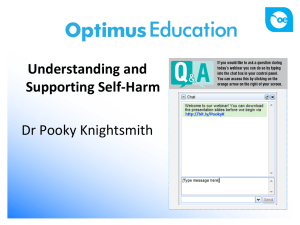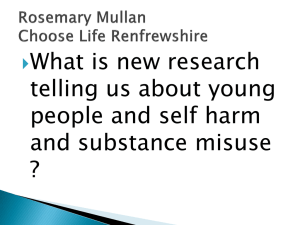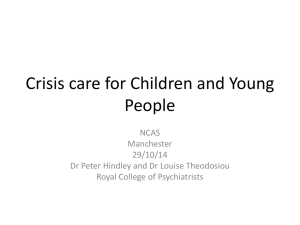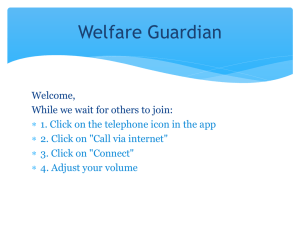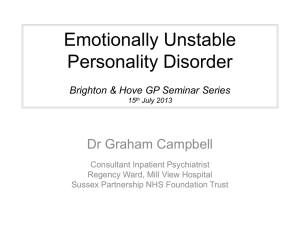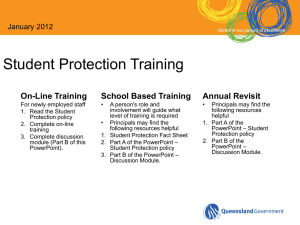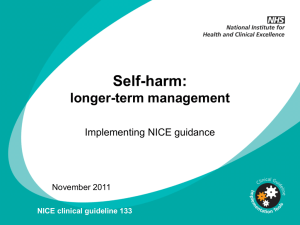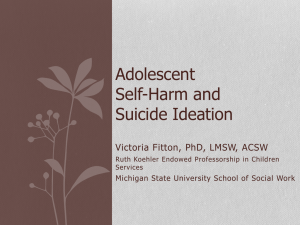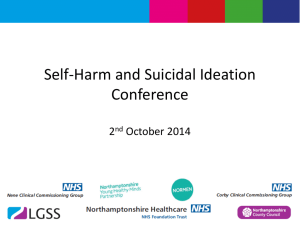Community Roundtable – Women and Girls who Self
advertisement
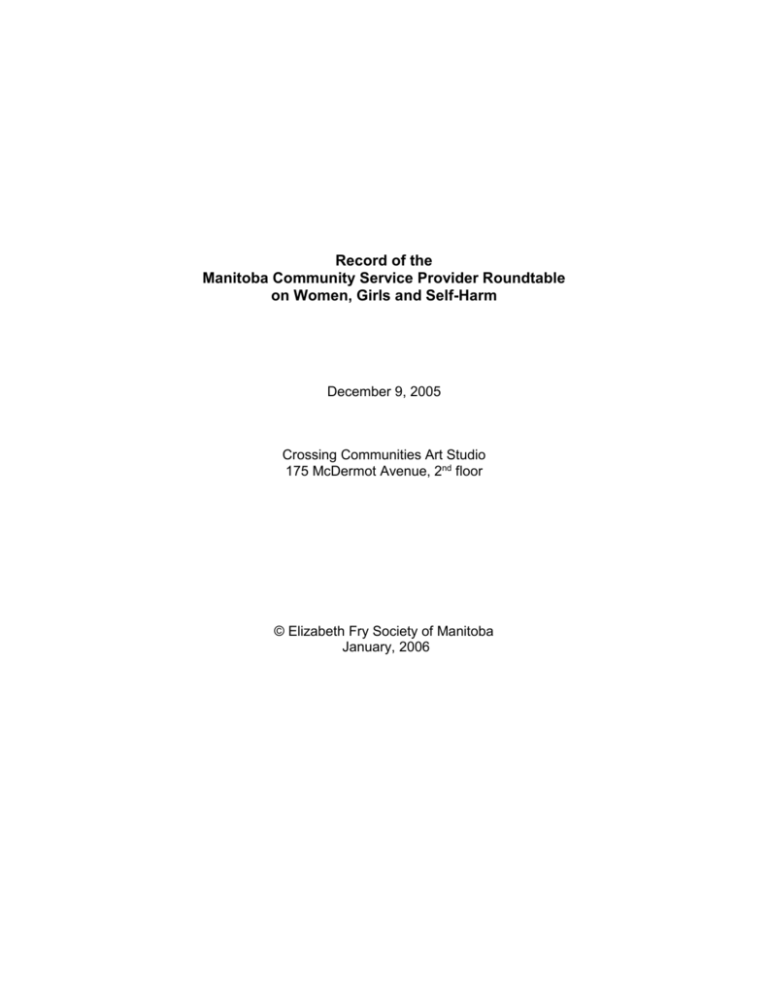
Record of the Manitoba Community Service Provider Roundtable on Women, Girls and Self-Harm December 9, 2005 Crossing Communities Art Studio 175 McDermot Avenue, 2nd floor © Elizabeth Fry Society of Manitoba January, 2006 BACKGROUND In 2001, the Elizabeth Fry Society (EFS) of Manitoba completed the first phase of an exploratory study on women and self-harm. This research was funded by the Prairie Women’s Health Centre of Excellence. The full report, Prairie Women, Violence and Self-Harm is available at: http://www.pwhce.ca/pdf/selfharm.pdf. The study focused on women’s perceptions of self-harm, their needs and the responses of community agencies and correctional institutions. In 2003, EFS of Manitoba conducted a follow-up study with support from the National Crime Prevention Strategy. This study had 3 objectives: (1) examine the awareness and perceptions of self-harm among a broad cross-section of community and institutional service providers in Winnipeg and rural regions of Manitoba, (2) gather information from service-providers on the resources (programs, supports and services) currently available to women and girls who self-harm, and (3) suggest guidelines for policies and programming based on the insights of service-providers involved in the care of women and girls who self-harm. The full report, Community Mobilization: An Environmental Scan of Manitoba Service Providers Who Work with Women and Girls Who Self-Harm can be accessed at: http://http-server.carleton.ca/~cadell/files_2005/Environmental_Scan_August25_FinalDraft.pdf An extended summary is also available in both English and French at: http://www.ccsa.ca/CCSA/EN/Topics/Populations/Women.htm A paper copy of the report can be obtained by contacting the Elizabeth Fry Society of Manitoba at (204) 589-7335 or 544 Selkirk Avenue, Winnipeg, MB, R2W 2N5. On December 9, 2005, 30 individuals representing 19 Manitoba service provider agencies and the community gathered for a full day to discuss the findings of the research report. All of the service agencies had completed a survey for the study. The goal of the community roundtable was to move toward the development of guidelines for the creation of context specific (e.g., correctional institution vs. community, age groupings) self-harm policy and programming. The meeting had three objectives: (1) information sharing, (2) networking, and (3) action planning around self-harm programming and policy. Members of the Manitoba Intersectoral Committee on Self-Harm, with the support of the Elizabeth Fry Society of Manitoba, the Canadian Centre on Substance Abuse, and the Crossing Communities Art Project, organized the community roundtable. Two note-takes, Jennifer Kilty and Jori Thorvardson, recorded the proceedings of the day. Leah Goodwin from Management and Communications Services facilitated the roundtable. This report is a record of the presentations and discussions that took place. AGENDA ACTIVITY PARTICIANT RECORD Opening prayer Betty/Morning Star – Elder Led a prayer that directed participants to take in courage and wisdom from the day. Welcome Edith Regier, Crossing Communities Art Project Welcomed participants to the art studio. 2 Roundtable Goal, Objectives & Agenda Janet Johnstone, Elizabeth Fry Society of Manitoba Goal: To move toward the development of guidelines for the creation of context specific self-harm policy and programming. Objectives: Information sharing, networking and action planning. Agenda reviewed. Front-line experiences at the EFS of MB have shown that there is a need for service providers to use common language (e.g., selfharm, self-injury), frontline service workers to advise government on policy creation (current lack of standard policy), the adoption of an addictions focus in services and programming, and increased education, services and programs in hospitals. The Intersectoral Committee on Self-Harm has been active in promoting the language of self-harm and sharing information. Introductions All See Appendix for list of participants Highlights of Research Report Colleen Anne Dell, Carleton University/ Canadian Centre on Substance Abuse & Cathy Fillmore, University of Winnipeg Highlights of the research report Community Mobilization for Women and Girls Who Self-Harm: Environmental Scan of Manitoba Service Providers presented. Edith Regier, Crossing Communities Art Project The Crossing Communities Art Project’s (CCAP) goal is social development through the visual arts. The CCAP art studios provide a safe space for criminalized women and girls to visually express their value and collectively make work with artists. CCAP stages exhibits and public forums with this artwork to engage community dialogues that explore alternatives to incarceration. Crossing Communities Art Project Video & Collaboration in Brazil Question/answer and comments - Fragmented policy is leading to disjointed practice. - The intention behind tattooing and piercing determines whether it is self-harming behaviour. - Uncertainty about Dialectical Behaviour Modification Therapy. - Clients need minimal wait times for services/counsellors. - Attention should be directed toward the root causes of self-harm (e.g., abuse, trauma) and link this with crime prevention strategies (that is, blending a health research focus with crime prevention strategies). - Concern expressed about whether women/girls sought help for their self-harming behaviours. And if they did, were they denied services and why (e.g., not fit agency mandate)? Also, how does the denial of services impact women and girls? Does it increase their self-harming behaviours and feelings of hopelessness? - Need improved hospital policies and services and an inventory of what exists. Viewed draft cut of video Cut to the Quick, directed by Pat Aylesworth. - A conversation about self-harm as a language. - Society marginalizes self-harm. - Cut to cope, not to kill. - Stigma surrounds self-harm so no one wants to talk about it or take time to listen to what is associated with it (it is identified as a mental illness without looking at the root causes). - Video poses many important questions & the need for answers. 3 Viewed video – Performance –“ In Memory of Darcie Hall” - Video was presented in Brazil. - An interview with Darcie Hall. - The healing process is about inclusion. - Highlights the “revolving door” service provided by hospitals (root cause of self-harming behaviours not addressed). - Self-harm is an unhealthy way of coping with underlying issues. Viewed photographs – Brazil Staging of Human Rights - People’s Palace project in Brazil is similar to the Crossing Communities Art Project. - Art as social development and social reform. Viewed 2 Art Project videos – The Stories of Tonya and Alexus - The videos were written, directed and acted in by the women themselves to allow for full creative control when speaking about their experiences with self-harm. Tonya - Began cutting, drug use and prostitution in early teens. - Originally thought she was cutting for attention, but realized she was keeping it hidden and it was a coping strategy. - Drug overdosed several times. - Does not want to commit suicide but does not know how to stopping cutting. Stated she is “on an instalment plan for suicide”, suggesting self-harm and suicide are linked on a continuum (selfharm is a form of communication). - Stopped cutting when in nursing school because her uniform would not hide the marks and she feared how patients would view her as a health care provider. - If not harming herself physically, she enters into abusive relationships so someone else is harming her. - When seeking help from service providers (especially hospitals), they do not address why she is cutting. - Hospitals need counsellors for crisis intervention and rooms other than the main ER so people do not stare. - Currently not welcome in detoxification facility because addicted to crack. - Had abusive experiences while in treatment. - Beneficial programs allow the person to return after relapse (e.g., Dreamcatchers program). Alexus - Personal issues can be addressed if people work together. - Loneliness causes individuals to refrain from sharing. - Wants to turn abuse and trauma into empowerment – this is why she is willing to discuss her experiences publicly. - Stressed the value of the Dreamcatchers program which recognizes sexual abuse is often linked to self-harm (this is often overlooked). - Personal issues are often interrelated. 4 The “How To” to Developing Guidelines for Self-Harm Policy (& Programming) Margaret HaworthBrockman, Prairie Women’s Health Centre of Excellence - Policy defined as what we want to do and how we want to do it. - Several elements are required to construct policy. These include: - Identify the objective and be specific (why should others care?) - Identify the audience (e.g., politicians, general public, policy makers) and word your objectives for this audience. - Identify immediate, medium and long terms outcomes to determine whether the policy is affective. - Identify indicators of success (e.g., number of people met with). - Identify social, economic and individual cost of the issue (link to why the issue is worthy of attention). - Identify consistent messaging (e.g., use of term self-harm). - Identify allies (collaboration between agencies demonstrates a strong community need). - Work with the media in order to get the information and message out. This will facilitate action. - Aim to create policy recommendations that are based in research and will lead to meaningful social change. - Key principles: (1) women centred, (2) respectful, (3) culturally appropriate (differences across Aboriginal culture; street culture; rural vs. urban culture), (4) non-judgemental, and (5) collaborative (community based). - Some of these elements can also be applied to program creation. Obstacles and Challenges Small Group Work - Lack of understanding and awareness about self-harm. - Absence of “champions for the cause”. - Language barriers (e.g., self-harm, self-injury, cutting). - Lack of understanding about the contributing factors to self-harm (failure to link environmental conditions and social context to selfharming behaviours). - Lack of communication and continuity in service provision between agencies. - Absence of services. - Lack of funding for programming. - Over-reliance on time-limited, private funding. - Inability of agencies and service providers to adapt to women’s needs. - Absence of women’s voices in programs/services. - Assumption among service providers that all women who selfharm have had the same experiences – require a more holistic, multi-dimensional and individualized approach. - Service providers need to recognize that the healing journey is different for everyone – therefore avoid a regimented timeframe and stop denying access because of relapse (relapse is often times part of recovery). - Need culturally sensitive counselling. - Need to train service providers to listen with sensitivity, have more patience and humour, and recognize power imbalance. - Stigma and bias surrounding individuals who seek access to treatment and programming for self-harm. - Need to overcome stigma surrounding mental health issues, poverty and the sex trade (e.g., media). - Policy language is gender and culturally neutral which creates a lack of awareness of women specific issues. - Reluctance by government to fully recognize the role of men in crimes against women who self-harm (e.g., impact of violence again women). 5 - No cost analysis of abuse in society (creates a disjuncture in understanding of abuse and self-harm). - No political will to listen to disenfranchised individuals. - Political pressure to identify simplistic indicators of success – it is more than just the number of people helped. Developing Guidelines for Programming and Policy – Key Suggestions Small Group Work - Begin with consensus around a definition of self-harm and language (use the Dell & Fillmore report as the foundation) (differentiate self-harm from suicide). - Service providers indicate own policy/programs/or services to identify gaps (and this will help eliminate duplicate services) (consult work conducted in the Environmental Scan). - Service providers create a set of “best practices” for their agencies to follow when dealing with self-harm (key is to move away from the current punitive approaches). - Involve funding partners in discussions and information sharing. - Incorporate the voices of women who self-harm in program and policy development. - Create an Advisory Board representing participants (past and present) of programs. - Use a holistic model (consider housing, income, health, emotional, spiritual, community, addictions, abuse). - Utilize a model of addiction that reflects the complicated issues that women face (e.g., social, economic, institutional). - Priority areas: - De-stigmatizing self-harm. Women and girls who self-harm are not a priority in the ER because it is self-inflicted injury– this is a punitive response and demonstrates bias toward women who selfharm and the stigma surrounding self-harm. - Development of peer support networks within agencies (train women with counselling/listening techniques) (in particular, have women speak to younger girls about the path they are headed on). - Direct prevention dollars toward youth. - Teach women how to identify alternative coping techniques (for example, the Crossing Communities Art Project). - Educate teachers in elementary and high school about self-harm. - Educate service providers on the causes of self-harm and on women’s individual needs. This understanding will lead to programs being adapted to what each woman needs rather than fitting them into the program. - Consult the Triple P (Positive Parenting Program) from Australia as a possible tool kit model. Action Planning Recommendations for Moving Forward All - Identify options for immediate service for women and girls who self-harm (no one should be turned away, including those who relapse), and long term seamless transition into other programs. - Communication and inter-agency referrals to ensure that no one gets “lost in the system”. - Self-care for frontline staff to prevent them from becoming overwhelmed. - Lunch and learn session where service providers come together to meet and discuss next steps. - Present the research findings at meetings of the Native Women’s Transition Centre and Mothers of Red Nation for Aboriginal specific action planning and ownership. Short-Term Goals 6 - Develop a list-serve for individuals who want to be involved in the next steps of addressing women and girl’s self-harm and want to keep informed on the issue. - Mail-out information packets to ministers, service providers, woman’s agencies etc. to inform them of the outcomes of the research/community roundtable. - Update original research plain language summary with new findings/community roundtable information (include programs/resources available to women). Long-Term Goals All - Develop a holistic and multi-dimensional approach to treating selfharm in programming and policy that is cultural and gender sensitive (in particular for Aboriginal women). - Develop venues for peer mentors and support (modelling). - Recognition by service providers that treatment time varies (allow for relapse in programming). - De-stigmatize self-harm and thereby eliminate women’s and girl’s shame through information sharing and education of service providers, particularly those in the medical and addiction treatment services. The less shame and stigma felt by women and girls who self-harm, the more they will be able to disclose. - Educate and raise awareness about self-harm among grade, middle and high school teachers and the general public so selfharming behaviours can be identified and addressed early on. - Train suicide hotlines and Kids Help Phone counsellors to provide immediate contact for a woman/girl in crisis. - Develop a DVD using the report, videos, personal stories to raise awareness about self-harm. - Uniform policy creation among service providers. IMMEDIATE NEXT STEPS The immediate next steps are: 1. 2. 3. Activity Action Prepare recording of the community roundtable and distribute to participants and invitees in January, 2006. Update plain language summary (incorporate new findings, community roundtable highlights, resources) Capitalize on opportunities to raise awareness about self-harm Completed 4th year undergraduate student at Carleton University, Hiba Yusuf, to produce first draft to Intersectoral Committee on Self-Harm in May, 2006. Completing as a course tutorial with Colleen Anne Dell. CrossCurrents, the Journal of Mental Health and Addiction, from the Centre for Addiction and Mental Health in Toronto highlighting self-harm/the Crossing Communities Art Project in its Spring issue. The Canadian Centre on Substance Abuse is developing a Fact Sheet on self-harm. 4. Begin to address short-term goals Hold a meeting of the Intersectoral Committee on Self-Harm. 7 APPENDIX Manitoba Intersectoral Committee on Self-Harm Canadian Mental Health Association Crossing Communities Art Project Department of Child & Family Services Eastman Region Probation Services Department of Health & Community Services IKWE-WIDDJIITIWIN INC. Ma Mawi Wi Chi Itata Centre Manitoba Women’s Advisory Council Misericordia Hospital Native Women’s Transition Centre Ndaawin New Directions Probation Services Special Needs Program, Manitoba Family Services and Housing Winnipeg Remand Centre Wolseley Family Place Organizing Committee for Manitoba Community Service Provider Roundtable on Women, Girls and Self-Harm Janet Johnstone, Executive Director, Elizabeth Fry Society of Manitoba Colleen Anne Dell, Assistant Professor, Carleton University & Senior Research Associate/Academic Liaison Canadian Centre on Substance Abuse, Intersectoral Committee on Self-Harm Co-Chair Cathy Fillmore, Associate Professor, University of Winnipeg, Intersectoral Committee on Self-Harm CoChair Edith Regier, Director/Resident Artist, Crossing Communities Art Project Jennifer Kilty, Research Associate List of attendees Sue Barnsley Colleen Anne Dell Cathy Doyle Wanda Ferland Cathy Fillmore Tracy Flaherty-Willmott Laura Gossen Shirl Hauser Margaret Haworth-Brockman Donna Huen Janet Johnstone Dina Juras Kathryn Kubrin Lisa Lloyd-Scott Jennifer Kilty Katherine Morrisseau-Sinclair Edith Regier Christine Rendulic Pam Robb Manitoba Women’s Advisory Council Carleton University & Canadian Centre on Substance Abuse The Behavioural Health Foundation Inc. Native Women’s Transition Centre University of Winnipeg Addictions Foundation of Manitoba, Youth Unit Addictions Foundation of Manitoba New Directions for Children, Youth and Families, Inc. Prairie Women’s Health Centre of Excellence MB National Crime Prevention Centre Elizabeth Fry Society of Manitoba MB National Crime Prevention Centre The Behavioural Health Foundation Inc. Winnipeg Health Sciences Centre, Children’s/Women’s Health Programs Research Associate Mother of Red Nations Crossing Communities Art Project Marymound Inc. Winnipeg Health Sciences Centre 8 Eleanor Robertson Marlene Stern Sharon Taylor Geri Thorsteinson Jori Thorvardson Pat Van Haute Corrine Warkentin Carrie Winslow Alexus Tonya Morning Star New Directions Winnipeg Regional Health Authority Wolseley Family Place Manitoba Women’s Advisory Council Crossing Communities Art Project Misericordia Hospital, Ambulatory and Acute Care Native Women’s Transition Centre Dreamcatchers Dreamcatchers Dreamcatchers Elder 9
